Abstract
Stimulation of corticotropin-releasing factor (CRF) release from the hypothalamus by interleukin 2 (IL-2) was recently demonstrated. Cytokines induce nitric oxide synthase (NOS), an enzyme that converts L-arginine into L-citrulline and nitric oxide (NO). NO is believed to be responsible for the cytotoxic action of these agents. The constitutive form of NOS occurs in neurons in the central nervous system and NO appears to play a neurotransmitter role in cerebellar and hippocampal function. We explored the probability that IL-2 and synaptic transmitters might release CRF via NO. The effects of L-arginine, the substrate for NOS, and NG-monomethyl-L-arginine (NMMA), a competitive inhibitor of NOS, on IL-2-induced CRF release were studied using mediobasal hypothalami (MBHs) incubated in vitro in Krebs-Ringer bicarbonate buffer. L-Arginine did not alter basal and IL-2-induced CRF release after 30 min of incubation but significantly elevated both basal and IL-2-induced CRF release when MBHs were incubated 30 min longer, presumably because the endogenous substrate had been depleted after the initial 30-min incubation period. In 30-min incubations, both carbachol, an acetylcholineomimetic drug, and norepinephrine stimulated CRF release. There was an additive effect of incubation of the MBHs in the presence of carbachol (10(-7) M) and IL-2 (10(-13) M). On the other hand, coincubation of MBHs with norepinephrine (10(-6) M) and IL-2 (10(-13) M) did not produce any additive effect. Addition of NMMA, an inhibitor of NOS, at 1 or 3 x 10(-4) M completely suppressed IL-2-induced release of CRF as well as that caused by IL-2 plus carbachol. In contrast, the release of CRF induced by norepinephrine was not blocked by 3 x 10(-4) M NMMA. The data indicate that IL-2 can activate constitutive NOS leading to increased NO release, which activates CRF release. It appears that NO is also involved in the release of CRF induced by carbachol but not by norepinephrine.
Full text
PDF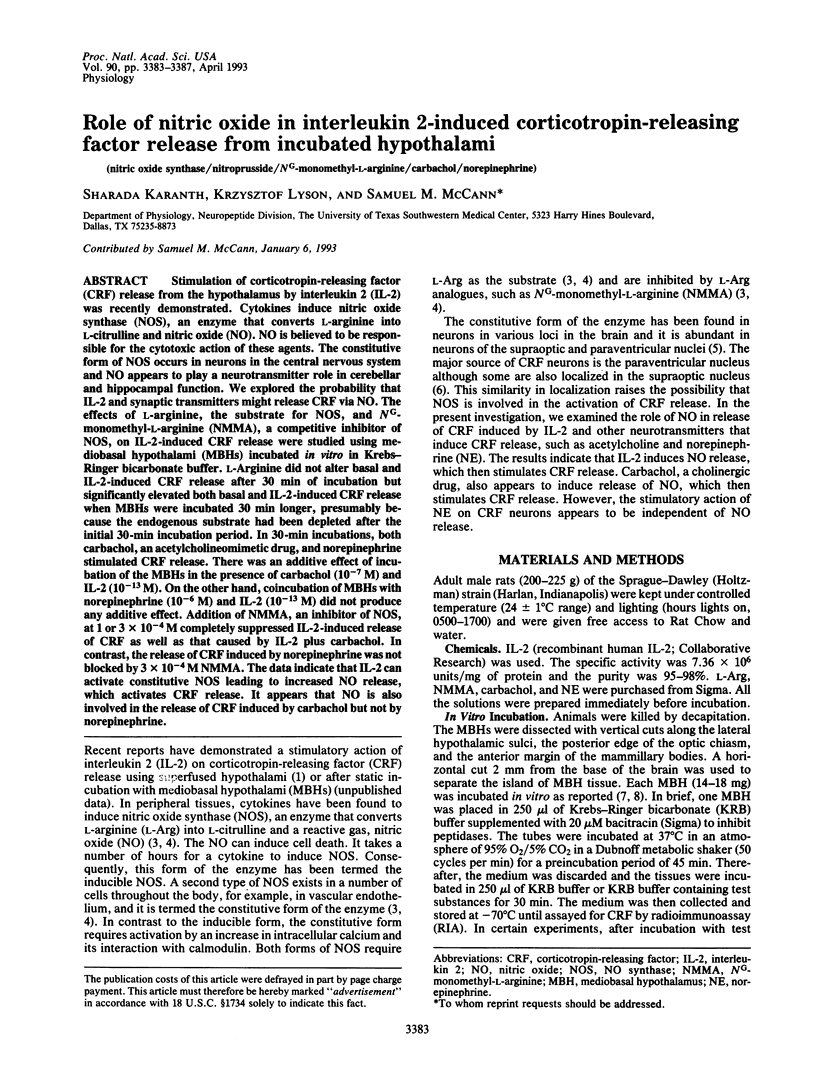
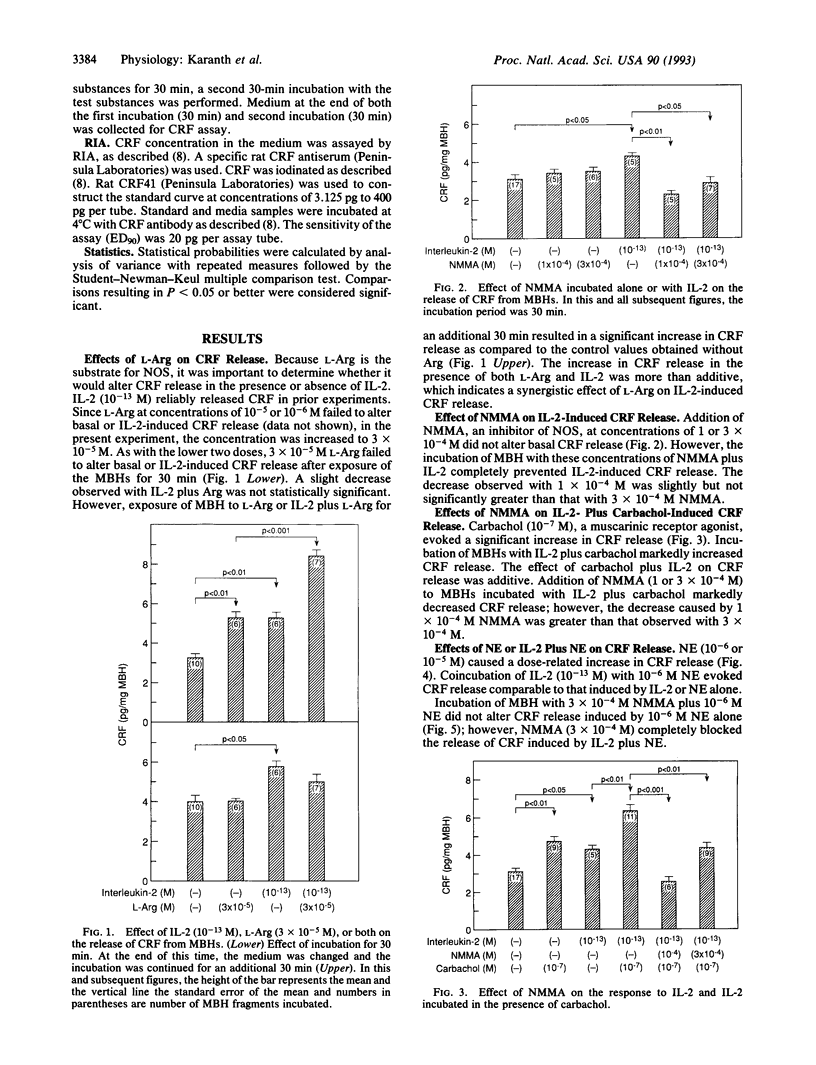
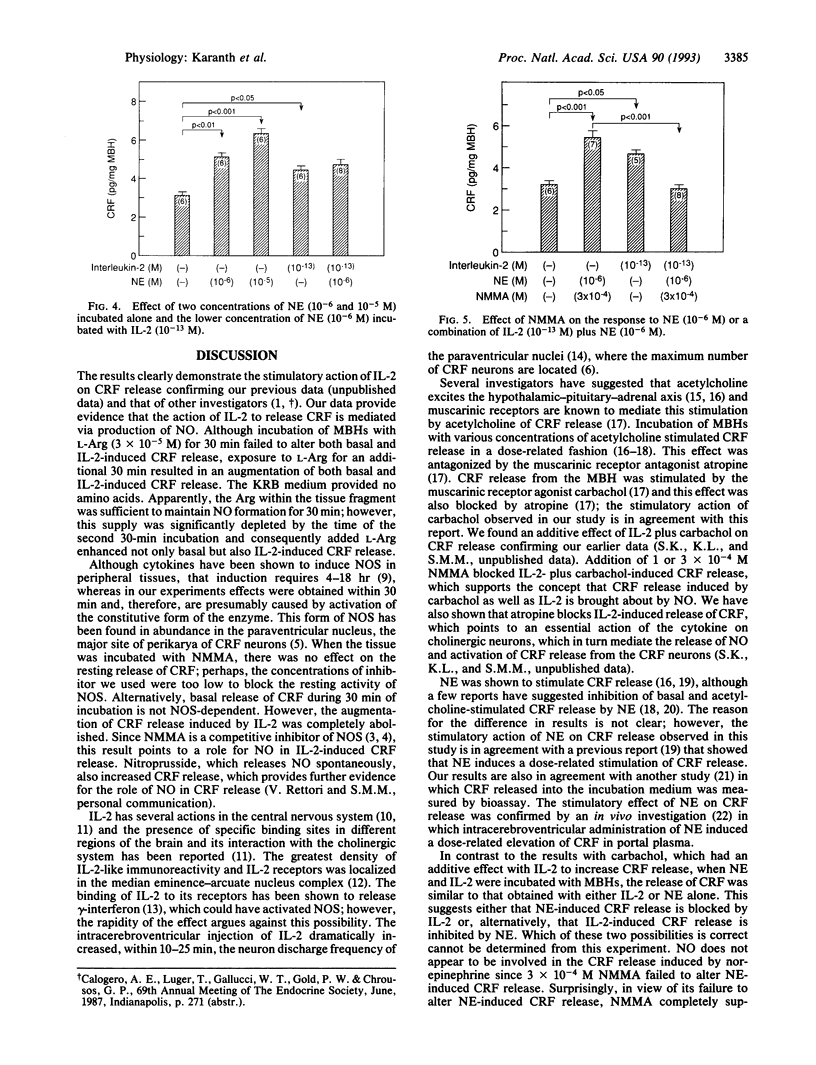
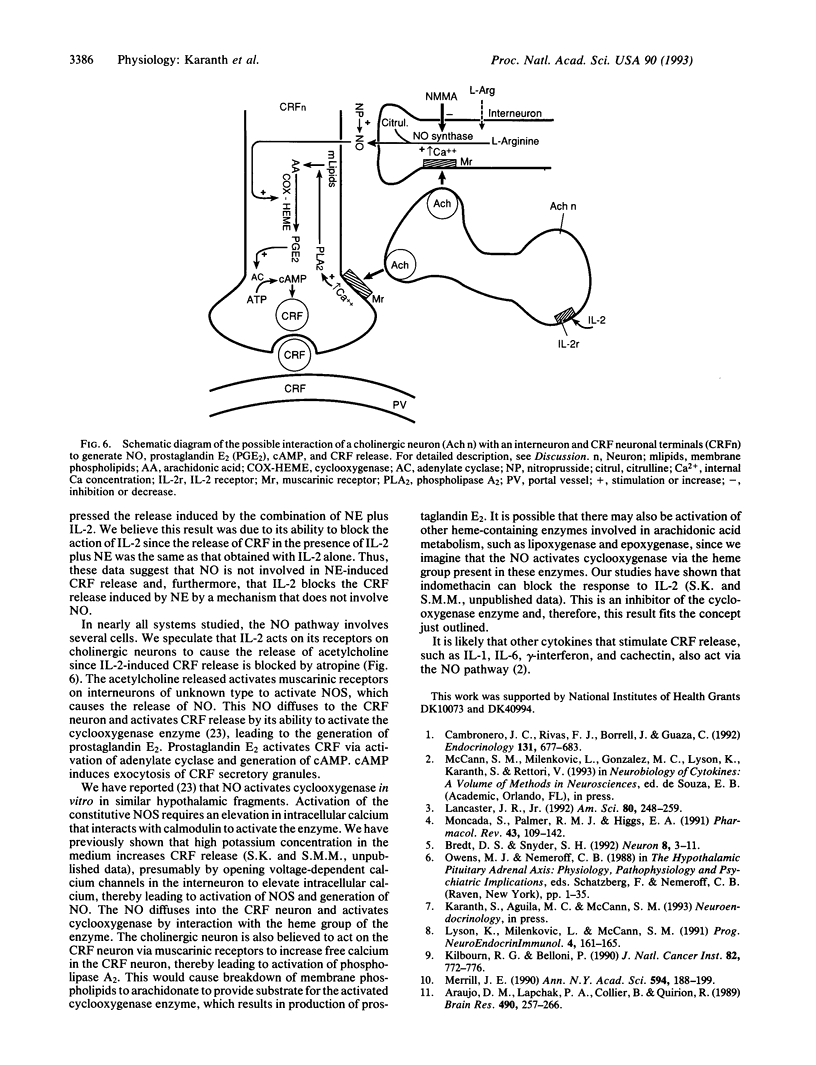
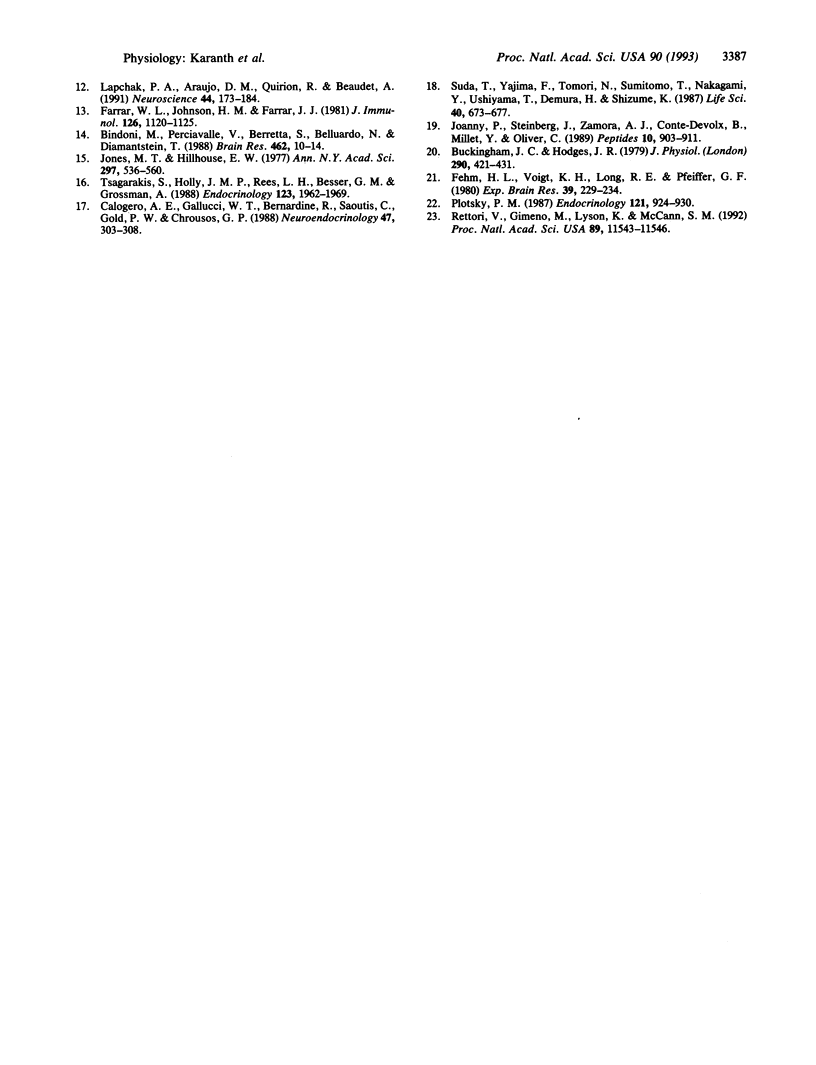
Selected References
These references are in PubMed. This may not be the complete list of references from this article.
- Araujo D. M., Lapchak P. A., Collier B., Quirion R. Localization of interleukin-2 immunoreactivity and interleukin-2 receptors in the rat brain: interaction with the cholinergic system. Brain Res. 1989 Oct 2;498(2):257–266. doi: 10.1016/0006-8993(89)91104-9. [DOI] [PubMed] [Google Scholar]
- Bindoni M., Perciavalle V., Berretta S., Belluardo N., Diamantstein T. Interleukin 2 modifies the bioelectric activity of some neurosecretory nuclei in the rat hypothalamus. Brain Res. 1988 Oct 11;462(1):10–14. doi: 10.1016/0006-8993(88)90578-1. [DOI] [PubMed] [Google Scholar]
- Bredt D. S., Snyder S. H. Nitric oxide, a novel neuronal messenger. Neuron. 1992 Jan;8(1):3–11. doi: 10.1016/0896-6273(92)90104-l. [DOI] [PubMed] [Google Scholar]
- Buckingham J. C., Hodges J. R. Hypothalamic receptors influencing the secretion of corticotrophin releasing hormone in the rat. J Physiol. 1979 May;290(2):421–431. doi: 10.1113/jphysiol.1979.sp012780. [DOI] [PMC free article] [PubMed] [Google Scholar]
- Calogero A. E., Gallucci W. T., Bernardini R., Saoutis C., Gold P. W., Chrousos G. P. Effect of cholinergic agonists and antagonists on rat hypothalamic corticotropin-releasing hormone secretion in vitro. Neuroendocrinology. 1988 Apr;47(4):303–308. doi: 10.1159/000124929. [DOI] [PubMed] [Google Scholar]
- Cambronero J. C., Rivas F. J., Borrell J., Guaza C. Interleukin-2 induces corticotropin-releasing hormone release from superfused rat hypothalami: influence of glucocorticoids. Endocrinology. 1992 Aug;131(2):677–683. doi: 10.1210/endo.131.2.1639014. [DOI] [PubMed] [Google Scholar]
- Farrar W. L., Johnson H. M., Farrar J. J. Regulation of the production of immune interferon and cytotoxic T lymphocytes by interleukin 2. J Immunol. 1981 Mar;126(3):1120–1125. [PubMed] [Google Scholar]
- Fehm H. L., Voigt K. H., Lang R. E., Pfeiffer E. F. Effects of neurotransmitters on the release of corticotropin releasing hormone (CRH) by rat hypothalamic tissue in vitro. Exp Brain Res. 1980;39(2):229–234. doi: 10.1007/BF00237553. [DOI] [PubMed] [Google Scholar]
- Joanny P., Steinberg J., Zamora A. J., Conte-Devolx B., Millet Y., Oliver C. Corticotropin-releasing factor release from in vitro superfused and incubated rat hypothalamus. Effect of potassium, norepinephrine, and dopamine. Peptides. 1989 Sep-Oct;10(5):903–911. doi: 10.1016/0196-9781(89)90167-8. [DOI] [PubMed] [Google Scholar]
- Jones M. T., Hillhouse E. W. Neurotransmitter regulation of corticotropin-releasing factor in vitro. Ann N Y Acad Sci. 1977 Oct 28;297:536–560. doi: 10.1111/j.1749-6632.1977.tb41881.x. [DOI] [PubMed] [Google Scholar]
- Kilbourn R. G., Belloni P. Endothelial cell production of nitrogen oxides in response to interferon gamma in combination with tumor necrosis factor, interleukin-1, or endotoxin. J Natl Cancer Inst. 1990 May 2;82(9):772–776. doi: 10.1093/jnci/82.9.772. [DOI] [PubMed] [Google Scholar]
- Lapchak P. A., Araujo D. M., Quirion R., Beaudet A. Immunoautoradiographic localization of interleukin 2-like immunoreactivity and interleukin 2 receptors (Tac antigen-like immunoreactivity) in the rat brain. Neuroscience. 1991;44(1):173–184. doi: 10.1016/0306-4522(91)90259-q. [DOI] [PubMed] [Google Scholar]
- Merrill J. E. Interleukin-2 effects in the central nervous system. Ann N Y Acad Sci. 1990;594:188–199. doi: 10.1111/j.1749-6632.1990.tb40478.x. [DOI] [PubMed] [Google Scholar]
- Moncada S., Palmer R. M., Higgs E. A. Nitric oxide: physiology, pathophysiology, and pharmacology. Pharmacol Rev. 1991 Jun;43(2):109–142. [PubMed] [Google Scholar]
- Plotsky P. M. Facilitation of immunoreactive corticotropin-releasing factor secretion into the hypophysial-portal circulation after activation of catecholaminergic pathways or central norepinephrine injection. Endocrinology. 1987 Sep;121(3):924–930. doi: 10.1210/endo-121-3-924. [DOI] [PubMed] [Google Scholar]
- Rettori V., Gimeno M., Lyson K., McCann S. M. Nitric oxide mediates norepinephrine-induced prostaglandin E2 release from the hypothalamus. Proc Natl Acad Sci U S A. 1992 Dec 1;89(23):11543–11546. doi: 10.1073/pnas.89.23.11543. [DOI] [PMC free article] [PubMed] [Google Scholar]
- Suda T., Yajima F., Tomori N., Sumitomo T., Nakagami Y., Ushiyama T., Demura H., Shizume K. Stimulatory effect of acetylcholine on immunoreactive corticotropin-releasing factor release from the rat hypothalamus in vitro. Life Sci. 1987 Feb 16;40(7):673–677. doi: 10.1016/0024-3205(87)90269-4. [DOI] [PubMed] [Google Scholar]
- Tsagarakis S., Holly J. M., Rees L. H., Besser G. M., Grossman A. Acetylcholine and norepinephrine stimulate the release of corticotropin-releasing factor-41 from the rat hypothalamus in vitro. Endocrinology. 1988 Oct;123(4):1962–1969. doi: 10.1210/endo-123-4-1962. [DOI] [PubMed] [Google Scholar]


